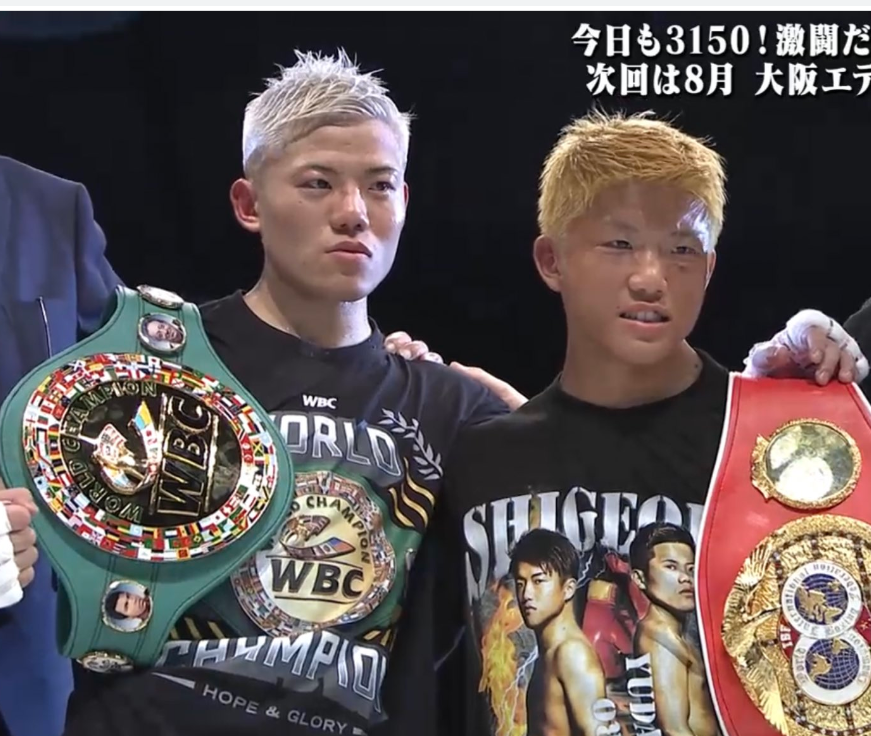Featured Articles
Shigeoka Brothers Score Impressive Knockouts in Tokyo

The Shigeoka brothers Yudai and Ginjiro have both delivered on the biggest nights of their careers in Tokyo, and as per last week’s preview, in impressive fashion. Ginjiro Shigeoka, now 9-0, took out Rene Mark Cuarto (The Philippines, now 21-4-2) with Yudai Shigeoka , now 7-0, scoring his victory over late substitute Wilfredo Mendez (Puerto Rico, now 18-3).
First to the ring was Ginjiro (pictured on the right), resplendent in gold gloves and trim, followed closely by Rene Mark Cuarto who appeared grim but confident. It felt clear form the first that this would be the predicted war, but what followed was as savage and complete an engine and gut-check as any young fighter might wish for. Cuarto stayed close, and Ginjiro welcomed him; the two were so close that they could comfortably tap gloves, Ginjiro’s southpaw right in direct weave with Cuarto’s orthodox left. Their first contact on the inside was dominated by Cuarto who landed a beautiful uppercut to the body that prompted a wild response from Ginjiro, one that underlined his immaturity. A feature of the first three rounds of this fight was a determination on Ginjiro’s part to even-up the cards after any negative contact, and it made him wild.
Ginjiro visited the deck twice in the first round, a slip, but then, overeager, under-corrected, Ginjiro was flashed to the canvas by a straight right hand to find himself facing the first genuine crisis in his fledgling career. He did not respond as his corner might have wished, throwing wildly, affording Cuarto chances for roughhousing, and throwing the fight into the type of abject chaos that a veteran was much more likely to profit by. It was Ginjiro, though, who won out in a violent clash of heads that left a spot of blood on Cuarto’s left cheek, a wound that would swell as the fight progressed.
In the third, Ginjiro made a meaningful and impressive adjustment, targeting the body, slotting them in behind minor feints with the jab and Cuarto, perhaps feeling the effects of the head-clash in the second, perhaps failing to digest these early sorties to the body, gave ground. Through the third and the fourth it felt as though the epic sweep of the violently contested sections were up for grabs among wild exchanges, but when he laid down his jab, Ginjiro dominated and seemed always just in control enough that he bagged these rounds. In the fifth, Cuarto managed to land a right uppercut to the body that impressed, prompting his corner to demand a further body attack, but it was Ginjiro, now calmer, more certain, that dominated the round with bodypunches, mostly left hands, as Cuarto appeared for the first time uncertain.
More pertinently, he had not won a round since the first. Truthfully, the more controlled Ginjiro’s attack became the more dangerous he became, and the straight punches he landed to the body in the sixth had Cuarto covering up in earnest for the first time. In fact, Ginjiro appeared to drop Cuarto with such a punch in the final minute of the round but while Cuarto’s corner bellowed loudly that this had been a slip, the ringside instant replay did indeed strike it off, the referee correcting his decision with the judges before waving the fight on. The referee, Katsuhiko Nakamura, was called to action again in the seventh, rightly issuing a stern warning to Cuarto who locked and then held Ginjiro in a guillotine. Ginjiro responded in the best of ways: a counter left to the pit of Cuarto’s gut that dropped him for a legitimate count.
It should be stated now: Cuarto, who had never been stopped going into this fight, is a very tough man. He fought back hard off the ropes despite Ginjiro continuing to target his body with severe punishment. Covering up in the eighth, he also refused to surrender but his tenderness in returning fire gave Ginjiro free reign to risk more. Adding to Cuarto’s misery was another clash of heads that left him with another cut, this time on the forehead.
Bloody, badly beaten to the body, but unbowed, he stepped out of his corner in the ninth ready to fight but unable to do so. He was a sitting duck for vicious left hands to the body and Ginjiro took full advantage, ripping into him and ripping him to the canvas not once, but twice. Cuarto, who had no quit in him, and made this fight every bit as much as Ginjiro, was waved off by the referee in the ninth round.
This was too one-sided an affair to be mentioned as a fight of the year contender, but it had everything. It saw a weak start from a favoured son who rallied violently in a fight that seemed poised on a knife’s edge, who then took control of the affair with superior technical boxing matched to the violence of the early rounds bound up in a vicious, measured body-attack.
A hugely impressive performance from Ginjiro then, it only remained to see if his brother could match it. As discussed in my preview last week, Wilfredo Mendez was a late-substitute for Panya Pradabsri and as difficult a late-substitute as could be roused. The test here was Mendez’s awkward, birdlike, crouching southpaw stylings in addition to his vaster experience. Yudai, all in silver, cut a far more cautious figure than his brother early, clearly out-speeding and out-touching his opponent but taking far fewer risks, relying in the main upon his own southpaw jab.
Yudai had Mendez running and holding as early as the second, one hoped in keeping with a plan that saw him rally late given that apart from some lefts to the body, Yudai’s offence was in the main still under wraps. Seemingly wanting to counter, Yudai was forced to wait for the Mendez attacks, which were intermittent to say the least, and although he inevitably won these exchanges, Mendez’s quickness on defence seemed to demand more from the Japanese. The best he could do in the fourth was beckon Mendez in before shipping the best punch of the round (a straight to the head) although he bagged this round along with the other three simply by out-sniping his man.
His patience was finally rewarded in the fifth, however, Mendez over-reaching with the left, a punch Yudai slipped to deliver a pair of beautiful, hard, narrow left hands to drop Mendez on his backside. Mendez escaped to his corner at the end of the count, but Yudai targeted his body with the same punch in the sixth, and Mendez, already in need of a knockout, seemed less keen to engage than ever.
It was something of a relief then when Yudai landed a whipping left to the body and Mendez took a crouch and stubbornly refused to abandon it until the referee had said “ten.” It is hard to say whether Mendez had been capable of beating the count, of course, and it was impressive to see Yudai feint him back into the corner right-handed before unleashing the final punch – but it did look like most of the finishing blow was captured on Mendez’s defences.
That said, it must be remembered who it is the brothers have knocked out today. Mendez was nothing less than the number twelve at 105lbs, whereas Cuarto could in no sensible sport be excluded from the top-ten. Cuarto had never been stopped, Mendez had been stopped just once, in eleven. These were impressive results posted by inexperienced fighters who have now made this division their playground.
Ginjiro, who has broken into the top five with this showing, is now impossible to ignore. He will presumably be re-matched with Daniel Valladares, in a rerun of their fight from January, abandoned after a clash of heads; Yudai meanwhile will presumably be matched with Panya Pradabsri, for whom Mendez was a late substitute. This though, underlines the division’s current problem.
The Thai twin-towers who rule over the division, Pradabsri and Thammanoon Niyomtrong, seem less than keen to leave their strongholds. Japan, meanwhile, holds the heavier promotional firepower and are likely to win any purse- bid. This situation might be manageable were it not for the atrocious reputation Thailand has as a fistic host currently, Erick Rosa, seen as a live threat to Thailand’s divisional hegemony, not just refused entry to the country but detained at the border when attending for a fight with divisional number one, Niyomtrong. Certain accusations have been made. Pradabsri’s withdrawal from the Yudai fight with a sore throat has not helped matters.
But it is a deep division, not always the case for 105lbs, and there are many pleasing fights to be made. If regional politics can be placed to one side there is room in the imagination for a Pradabsri-Yudai, Niyomtrong-Ginjiro showdown. The most difficult task in boxing is to place minimumweight at the centre of the fistic world; it can only be hoped that the powers that be don’t pass up such a rare opportunity.
To comment on this story in the Fight Forum CLICK HERE
-

 Featured Articles4 weeks ago
Featured Articles4 weeks agoAvila Perspective, Chap. 330: Matchroom in New York plus the Latest on Canelo-Crawford
-

 Featured Articles3 weeks ago
Featured Articles3 weeks agoVito Mielnicki Jr Whitewashes Kamil Gardzielik Before the Home Folks in Newark
-

 Featured Articles8 hours ago
Featured Articles8 hours agoResults and Recaps from New York Where Taylor Edged Serrano Once Again
-

 Featured Articles4 weeks ago
Featured Articles4 weeks agoCatching Up with Clay Moyle Who Talks About His Massive Collection of Boxing Books
-

 Featured Articles5 days ago
Featured Articles5 days agoFrom a Sympathetic Figure to a Pariah: The Travails of Julio Cesar Chavez Jr
-

 Featured Articles3 weeks ago
Featured Articles3 weeks agoMore Medals for Hawaii’s Patricio Family at the USA Boxing Summer Festival
-

 Featured Articles7 days ago
Featured Articles7 days agoCatterall vs Eubank Ends Prematurely; Catterall Wins a Technical Decision
-

 Featured Articles4 weeks ago
Featured Articles4 weeks agoRichardson Hitchins Batters and Stops George Kambosos at Madison Square Garden




















